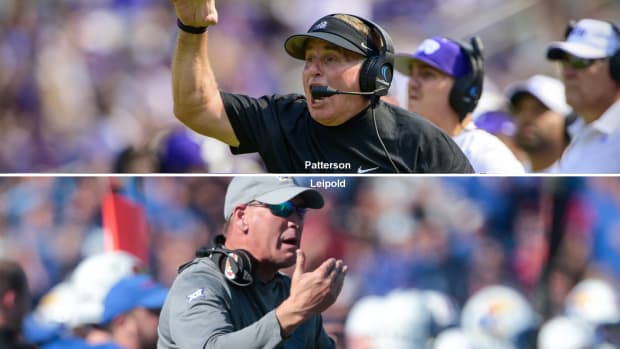

The college football landscape is changing. With recent and future expansion, the SEC and Big Ten are becoming college football’s superpower conferences. Jobs in these conferences now have more allure than ever. They offer more stability and come with far more resources and opportunities than their counterparts.
All of the head coaches on my list for Nebraska are currently at schools that aren’t in one of these conferences. Perhaps just as important, when realignment commences in the future, none of the schools they are at will get serious consideration to join.
It’s a point of emphasis I would make to prospective coaches. Thanks to its new media rights deal, the Big Ten is projected to eventually distribute upwards of $100 million per year to each of its 16 members. In many cases, that’s more than triple what the schools are getting where these coaches are currently. Nebraska also just signed a 15-year, $301 million multimedia rights agreement with PlayFly Sports, which is one of the largest MMR deals ever with a university.
Next summer, Nebraska is set to cut the ribbon on a $165 million, 350,000-square-foot athletic facility that will be among the best in the country. Athletic director Trev Alberts is also in the early planning stages to renovate and modernize Memorial Stadium.
Less than three weeks ago, an independent group led by prominent Nebraska alumni launched a brand new NIL collective for Husker athletics that has been publicly endorsed by Trev Alberts. The new “Big Red Collective” will join Athlete Branding & Marketing (ABM) as prominent NIL vehicles for Husker athletes. The pieces are in place for the next head coach.
Speaking in front of a packed house inside Millard Social Hall last week, Trev Alberts said it best; “Somebody is going to look at our job and say ‘wow, this is a diamond in the rough.’ This is an incredible opportunity. But it’s the right type of personality. It’s somebody who wants to build. It’s somebody who loves challenges. And it’s somebody who wants to say, ‘I could be the coach that helps bring this program back to the respectability that we all seek to attain.’”
With the College Football Playoff set to expand to 12 teams in 2026 (perhaps as early as 2024), schools like Nebraska will have an easier path to get in. With the resources and advantages I mentioned above, with the right coach in place, there’s no reason Nebraska can’t be a school that’s in contention for one of those 12 spots on a semi-regular basis. None.
Not only can Alberts sell that, but I think the coaches he’ll target will know that too. Coaches have egos. I think guys who’ll want this job have looked at what’s been going on the last eight, 10 years in Lincoln and wondered “what the heck is going on there?” I think coaches look at Nebraska and think “I could win there.”
Everyone talks about the inherent recruiting disadvantages for schools in the Midwest, but the changing landscape is helping to mitigate that. The transfer portal and NIL can help level the playing field a bit for a school like Nebraska that is isolated from recruiting hotbeds. The program wants to continue to be very aggressive in utilizing NIL, which should be enticing to the right coach.
Besides, look at the recruiting rankings Scott Frost had before he was on the hot seat; 23rd (2018), 17th (2019), 20th (2020), 20th (2021). He was getting those while his teams were playing like garbage on Saturdays. If the right coach comes in and starts winning, those classes have the potential to be higher. I’ve always felt if Nebraska were winning 8+ games a year and had the right coaching staff in place who grind on the recruiting trail, there’s no reason the Huskers couldn’t live in the top 20 every year with an occasional top 10 class here and there.
Having said that…
There are several coaches who I think would make for good hires at Nebraska. Many aren’t likely to consider (or be considered for) the job, however. Some are probably content in their current situations and too comfortable to leave. Some might not be regional or cultural fits. Some might want to wait for a bigger opportunity. Coaches who fall into that category for me include Mark Stoops (Kentucky), Kyle Whittingham (Utah), Lane Kiffin (Ole Miss), Sam Pittman (Arkansas), Dave Doeren (NC State), Mike Gundy (Oklahoma State), Kalani Sitake (BYU), Dave Clawson (Wake Forest), Pat Narduzzi (Pittsburgh), Kalen DeBoer (Washington) and Bret Bielema (Illinois). Some of these names I like more than others, but each of them can make a case for being Nebraska’s next coach.
I’d like to focus on two coaches Nebraska could get that intrigue me.
The first is former TCU head coach Gary Patterson, who is currently on staff at Texas making $150k as special assistant to head coach Steve Sarkisian. After four straight underwhelming seasons, Patterson resigned Week 10 last season after he was told the program would be making a coaching change. He reportedly turned down several offers from Power Five schools to be their defensive coordinator and instead decided to join Sarkisian’s staff in Austin so that he could work behind the scenes out of the spotlight.
Along with offering big-picture advice to Sarkisian, Patterson serves as an analyst to defensive coordinator Pete Kwiatkowski. Famous for his 18-hour day work ethic, Patterson grinds in his office scouting opponents and putting together game plans. Long considered one of the finest defensive minds in college football, Patterson is the one who is credited for the masterful defensive strategy the Longhorns implemented against No. 1 Alabama that nearly led to an upset.
Nebraska could use a program builder and Patterson certainly fits the mold. Full disclosure, Patterson was one of three coaches who I lobbied for after Bo Pelini was fired following the 2014 season. The other two being Kyle Whittingham and Stanford’s David Shaw.
When Patterson first took over TCU as its interim head coach in late 2000, the program was a national afterthought. A few years earlier, TCU had been left out of the merger between the Big 8 and its former home the Southwest Conference, landing in the lowly Western Athletic Conference after the creation of the Big 12 in 1996.
Along with being its head coach, Patterson was also TCU’s defensive play caller. He devised a 4-2-5 base defense that was cutting edge at the time. It has subsequently been appropriated by nearly every school in college football in some capacity.
When Patterson took over full-time in 2001, the Horned Frogs were set to join Conference USA. From there, TCU’s football success under Patterson became the catalyst that kept the school moving up the conference ladder. They joined the Mountain West in 2005 and after a dominant run in that conference, the program came full circle when it was invited to join the Big 12 in 2012, after the departure of Texas A&M.
Patterson was 181-79 (113-59 in conference) in nearly 21 full seasons at TCU, winning six conference championships; 2002 (Conference USA), 2005, 2009-2011 (Mountain West) and 2014 (Big 12). He was named national coach of the year in 2009 and 2014, while also earning conference coach of the year honors in 2002 (Conference USA), 2005, 2009 (Mountain West) and 2014 (Big 12). Is there any wonder why TCU has a statue of him outside Amon G. Carter Stadium?
Under his leadership, TCU boasted double-digit wins 11 times. The Horned Frogs had seven top ten finishes and four additional top 25 finishes. Patterson took his team to 17 bowl games, going 11-5 (the 2020 Texas Bowl was canceled due to COVID-19 issues).
Had the College Football Playoff been around in 2009 or 2010, his TCU teams may have been part of them. His 2014 squad nearly was. The committee had ranked TCU No. 3 in the week before college football’s conference championship games. They controversially dropped the Horned Frogs to No. 5 in its final rankings a week later, despite a 55-3 win over Iowa State.
What’s so impressive about Patterson’s accomplishments, is historically its been difficult to attract top talent to Fort Worth. Not only did they struggle because of the mid-level conferences they were stuck in, but even after joining the Big 12, they couldn’t compete with the resources or prestige many schools have that also recruit Texas. Keep in mind, there are 12 FBS programs in the state of Texas. That’s not including other regional and national programs that make it a habit to mine the Lone Star State as well.
As a result, Patterson and his staff relied on their evaluations to identify primarily under-the-radar, under-recruited, or overlooked prospects to build his teams. Then when he got them on campus, he did an outstanding job of developing those players. Patterson always had to do more with less, and often did.
His teams were known for their toughness and effort, traits that certainly resonate with Nebraska. “I like people who hate to lose more than they enjoy winning,” Trev Alberts said at his press conference. Gary Patterson personifies that.
So case closed, right? Patterson has said his battery is recharged and would like to be a head coach again. Grab him. What’s the catch?
Well, a few things give me pause. Patterson’s approach was similar to former Husker head coach Bo Pelini’s in some ways. He’s a strong-willed, no nonsense coach. He often comes off demonstrative and abrasive and rubs some people the wrong way.
Patterson had earned the dreaded “old school” label in the last four or five years of his tenure at TCU. Some around the program felt he had become stuck in his ways an unwilling to change with the times.
By some accounts, Patterson began to grate on his players. There were concerns raised publicly from some on the team over player-safety issues and allegations that Patterson forced injured players to participate.
Another possible red flag are some of the public statements Patterson made his last few seasons in Fort Worth regarding his disdain for the direction college football was heading. His management style didn’t seem a good fit for the new NIL and transfer portal era. In fact, he publicly criticized both. Today’s environment is shifting towards coaches having to continually re-recruit players already on the team, giving them reasons not to just go to a school but to stay there. The way Patterson was perceived and based on his comments, he doesn’t seem like someone who would embrace that. He was also known to severely limit media access to his players, which can effect NIL potential.
Patterson will be 63 years old in February, which is already a bit older than your ideal candidate. Can he change? He’ll need to in order to succeed in college football’s 21st century landscape.
Scroll to Continue
Has his time around Sarkisian’s program opened his eyes to a different approach? Sark absolutely embraces NIL and the portal, and realizes its potential in recruiting and roster building. Patterson’s comments this past summer suggest his time in Austin is leaving a mark.
“One of the things about coming to Texas for me was you’ve got guys who came from Alabama and Sark has coached at USC – all these different places,” Patterson said in an interview. “So I’ve been learning also. There’s things in recruiting I’ve learned that I think I’d take. There’s been things I’ve learned being here that have been good for me if I would ever go back and (be a head coach again). You’ve got a lot of guys who’ve come from a lot of good programs and won a lot of ballgames. That’s been a big positive for me, which is one of the things I’ve been most excited about.”
Another intriguing option is current Kansas head coach Lance Leipold. This is a name most Husker fans already know and someone many are pulling for to get the job. Leipold was an administrative assistant on Frank Solich’s staff from 2001-03, where his responsibilities included maintaining the recruiting video database and assisting with on-campus recruiting functions. Because of that Husker connection, many fans have been monitoring his career with great interest.
In 2007, Leipold was hired as the head coach of his alma mater. He would go on to become one of the most accomplished coaches in the history of Division III football. Leipold, 58, went 109-6 with six Division III national championships (2007, 2009–2011, 2013–2014) in eight seasons at Wisconsin-Whitewater, where he played quarterback from 1983 to 1986. He was also named Division III national coach of the year in corresponding seasons.
After coaching 56 All-Americans and building a Division III powerhouse, Leipold left to take over a historically dreadful Buffalo program in 2015. Leipold was 37-33 in 6 years at Buffalo, but was 24-10 his last three years after turning the program around. Leipold coached 49 All-MAC selections, with 35 of those coming in his final three years.
Leipold twice was named Mid-American Conference Coach of the Year (2018, 2020) while winning two division championships. He led the Bulls to three consecutive bowl games and the only two bowl wins in school history. In 2018, Buffalo won 10 games for the first time in program history, which dates back to 1962. In 2020, Buffalo finished ranked in the AP Top 25 for the first time in program history.
On April 30, 2021, Leipold got the job at Kansas, beating out Army’s Jeff Monken. He replaced Les Miles, who was dismissed March 9, after an LSU investigation revealed allegations of inappropriate behavior toward female students during his tenure as Tigers coach.
Kansas is one of the most difficult jobs at the Power Five level and required a massive rebuild. When Leipold took over, the Jayhawks were 21-99 since 2010 and hadn’t had a winning season since Mark Mangino went 8-5 in 2008. Leipold is the team’s sixth head coach since that last winning campaign.
Leipold’s late hire robbed him of a full offseason with his new team and stunted his rebuild. His new strength staff weren’t afforded a winter conditioning or even a full summer session to get players training how he wanted. Leipold and his staff didn’t have spring practices to help players get acclimated to the new systems.
But Leipold is a builder and he dove right into flipping the roster and establishing his culture. Since June 2021, 45% of the scholarship players have changed. Kansas has added 31 transfers since Leipold’s arrival, and the roster looks completely different than it did during Les Miles’ tenure.
Not surprisingly, it took a while for Leipold’s team to start clicking. The Jayhawks were 2-10 last season, but started showing some signs in November. Kansas beat Texas for the first time since 2016 and lost by a total of 9 points to TCU and West Virginia to end the year.
Kansas signed Leipold to a one-year extension prior to the 2022 season. The extension brings Leipold through the 2027 football season, and he’ll make $3.5 million in the final year of the deal. His buyout is $5 million, so financially, there’s not much of a roadblock if Alberts decides to target him.
This season, Leipold has Kansas 5-0 for the first time since 2009, which is also the last time the Jayhawks won more than three games in a season. Kansas is ranked No. 19 and is in the AP Top 25 for the first time since Oct. 18, 2009, ending the Power Five’s longest active drought.
The excitement in Lawrence is palpable. Kansas had back-to-back sellouts for their games against Duke and Iowa State. Prior to that, they hadn’t had a sellout since 2019 and that had been just their second in the past 13 seasons.
Recruiting at a Power Five conference for the first time, Leipold has shown the ability to shift gears. While at Buffalo, he recruited primarily the East Coast. After moving to Kansas, you’ve seen Leipold’s recruiting operation shift its areas of focus, with the Jayhawks recruiting more in Texas, Florida, Georgia and the Midwest. Mirroring fellow regional teams like Nebraska and Iowa State, Leipold has been aggressive with early evaluations and offers.
Kansas has never been a program that typically attracts top recruits. According to Rivals, dating back to 2002, Kansas has never had a class ranked higher than 31st (2009). From 2002-2021, their classes averaged No. 52. With barely 10 months to assemble it, Leipold only signed 12 players in his first class, which ranked 117th according to the 247Sports Composite (unranked by Rivals). Most recruiting classes are a two year culmination – sometimes longer. You simply can’t take much away from his initial class.
Unfortunately, there just isn’t enough data to prove whether or not Leipold’s efforts will translate into better results than what Kansas historically has gotten. The Jayhawks currently have nine commitments (all three-stars) in its 2023 class, but with nearly three months until the early signing period, there are still a lot of moving parts.
Regardless, from a recruiting perspective, it’s a roll of the dice to bring in a coach like Leipold. He would come to Lincoln having never spent a normal recruiting cycle assembling a Power Five class. It’s a concern. Leipold also has no previous experience recruiting in areas that would be a point of emphasis at Nebraska. I’d want to have tangible results that I can reference if I’m Alberts. I don’t want to have to assume or project recruiting success. Especially when the coach doesn’t have a history in the region.
That’s really where my biggest concerns are with Leipold. Not just with his finite recruiting background at this level, but his limited body of work at the Power Five in general. You can’t argue with what he did at Wisconsin-Whitewater and Buffalo, but if he’s hired at Nebraska, he’ll arrive in Lincoln with roughly 18 months experience at the Power Five level. Is that enough to make you confident with the hire? Does it alleviate concerns about him maintaining success at a Power Five school, let alone a place like Nebraska? College football is littered with examples of coaches who had success at mid-level schools but flamed out on the big stage.
Bo Pelini, Mike Riley and Scott Frost all struggled to build a team that was compatible with the Big Ten. Ideally, you want the new coach to have a history in the league so that he knows how to build to contend in this conference from Day 1. That means assembling a staff and structuring your recruiting efforts to fit the conference. Pelini, Riley and Frost all struggled with that.
That brings me to another concern I have with Leipold, which is his coaching staff. When he took the job at Kansas, he brought five coaches with him from Buffalo and kept five from the previous staff. Because of the odd timing of his hire, I can understand it being difficult to cobble together a coaching staff. It didn’t come as a surprise to see more shakeup on the staff after the 2021 season when all parties had more options. But Leipold’s subsequent hirings left a lot to be desired in my opinion.
Following his first season in Lawrence, Leipold fired two of his inherited assistants and replaced them with two in-house senior analysts. One was a demoted assistant from Les Miles’ staff and the other was an assistant of Leipold’s from Buffalo. Two other holdovers left on their own to join other staffs. I’m not overly impressed by the staff he’s put together, with six of 10 assistants being Buffalo holdovers, including both coordinators who have been with him since his time at Wisconsin-Whitewater.
Nearly all of his assistant coaches have backgrounds primarily at the Group of Five or FCS levels. Based off of résumés, Leipold’s staff is less accomplished than Frost’s UCF staff, and its no secret how I questioned that group when it arrived. That might be okay at Kansas, but we saw the effects of Scott Frost bringing an entire staff of coaches with him from UCF who were largely in over their heads in the Big Ten.
Is that because it’s Kansas and his options are limited? Even so, I would have liked to see Leipold bring in coaches with backgrounds in areas that were more aligned with where he wanted to recruit at Kansas. There are a lot of really good up-and-coming assistants in conferences like the Mountain West, Sun Belt and MAC. Even with it being Kansas, there are plenty of assistants in those conferences who would offer an upgrade and would jump at the chance to coach Power Five.
If we’ve learned anything from watching four different Husker coaching staffs over these past 20 years, it’s the importance of putting together a staff that can recruit. Just as important, those coaches need to be able to recruit areas that actually benefit Nebraska.
Since Nebraska’s been in the Big Ten, we’ve seen Mike Riley put together a staff of coaches with primarily Pac 12 backgrounds, and despite all the ‘Calibraska’ hype, those recruiting connections never paid off. Scott Frost brought a staff with very limited Power Five experience and was largely devoid of coaches with recruiting connections in the Big Ten.
And that’s just the recruiting ramifications. You want coaches with a background in the conference you’re joining who know how to recruit to it, yes, but also how to play in it. You need coaches on staff that know the conference and the style of play. Coaches who have already had to scout and game plan against these teams. Coaches with an idea of what their team needs to be in order to compete in the Big Ten. Bo Pelini, Mike Riley and Scott Frost never acclimated to the Big Ten. Pelini had a team built for the Big 12 and never adjusted properly. Riley’s Pac 12 systems weren’t an ideal fit. And we all know the Big Ten never had to “modify its system” to stop Frost’s AAC approach.
Some of the best coaches in college football are in the Big Ten. How many times did we see Pelini, Riley and Frost simply get out-coached, out-adjusted or out-schemed? Too many.
If I’m Alberts and I’m interviewing Leipold, I’m asking him about his network and who he envisions on his staff. Does he have the Rolodex to put together a staff of coaches that can win and recruit well in the Big Ten? He’s becoming a hot name in coaching circles, can he parlay that into assembling a top staff? If he plans to hire more established coaches to fill out his staff, that would ease my concerns. In fact, for me it would be mandatory.
Nebraska’s next coach will need to have tremendous evaluation skills, which Leipold may have, but he’ll also need to have a staff of proven recruiters. Coaches who have connections to vital Midwest recruiting areas where Nebraska wants (needs) to have a major presence like St. Louis, Kansas City, Chicago, Denver, Minneapolis and Indianapolis. Not only is Leipold a novice in those areas, but so is his current staff.
Leipold is an interesting candidate, no doubt about it. Like Gary Patterson, he wouldn’t necessarily be a bad hire by any means. I just have a core group of five that I would be more interested in and more confident in if I were Alberts. I’ll discuss them next week.

Must See
-


Football
/ 2 months agoHuskers Fight Hard but Fall Short Against UCLA
LINCOLN – The Nebraska Cornhuskers gave it their all on Saturday, with standout efforts...
-
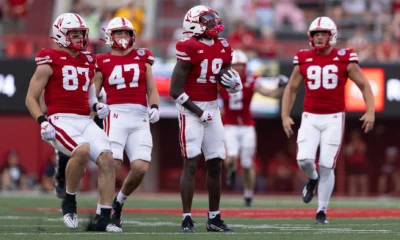

Football
/ 2 months agoGAMEDAY: Nebraska Set to Face Undefeated Indiana in Key Big Ten Showdown
Bloomington, IN – It’s Game Day, Husker Nation! Nebraska (5-1, 2-1 Big Ten) returns...
-


Football
/ 2 months agoBlackshirts Shine as Nebraska Tops Rutgers 14-7 on Homecoming
Lincoln, NE – Nebraska’s Blackshirt defense played a starring role in the Huskers’ 14-7...
By Chris




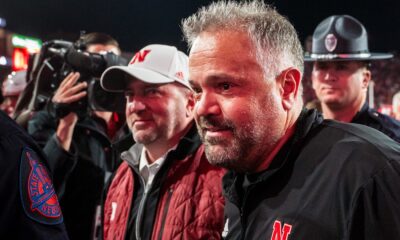

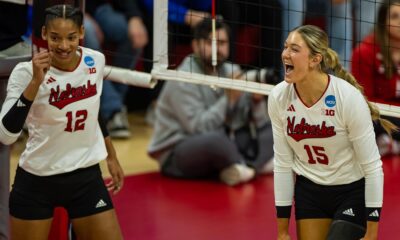

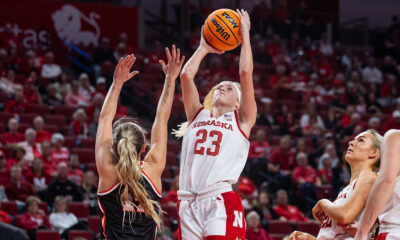

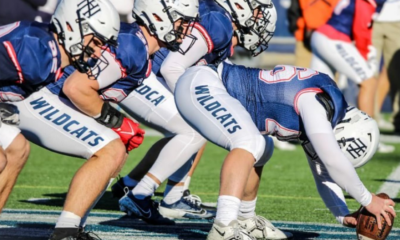

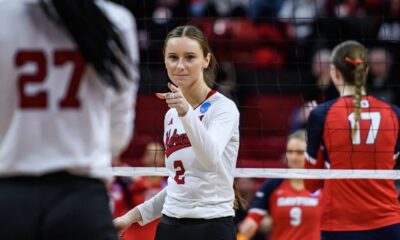




You must be logged in to post a comment Login